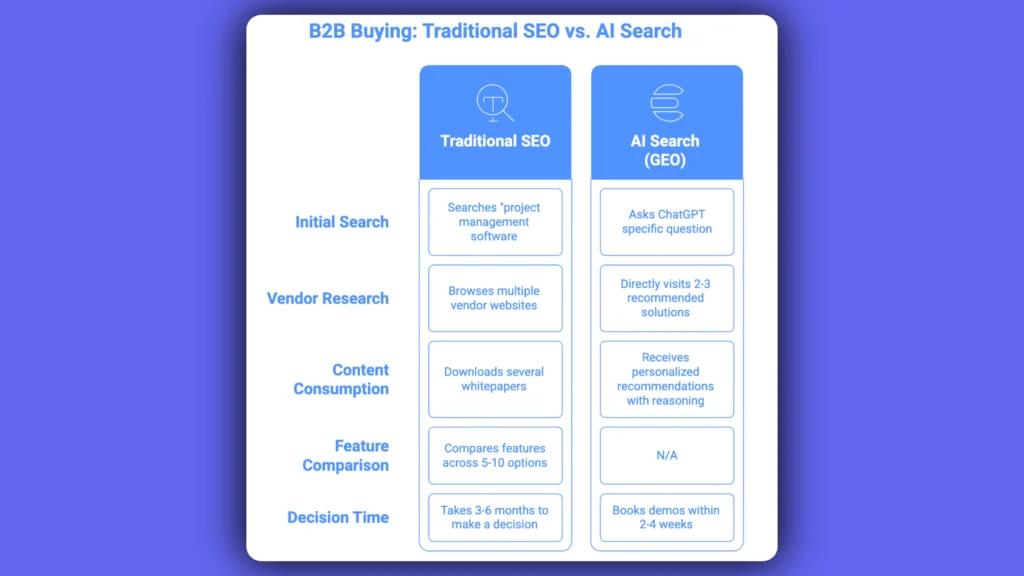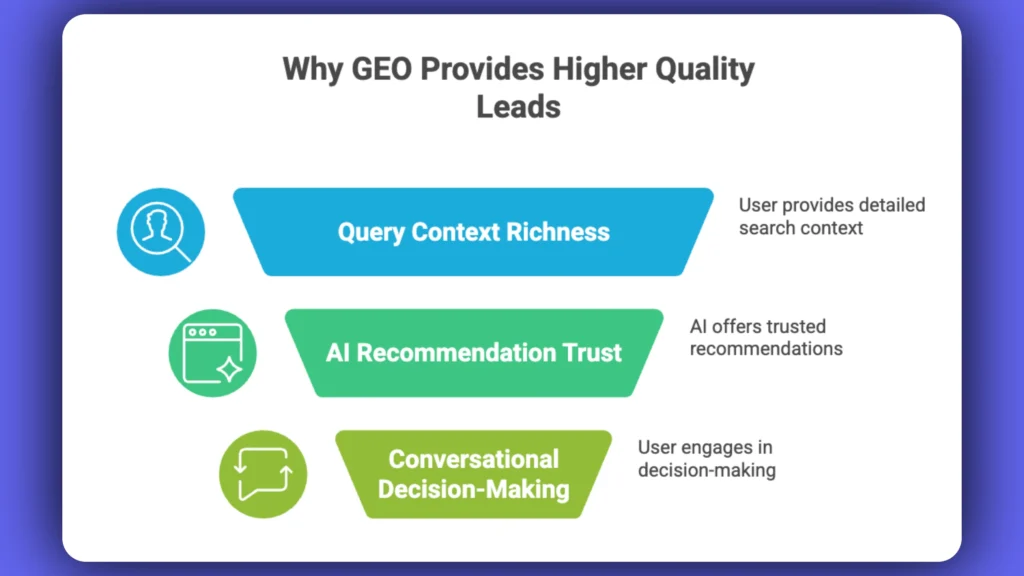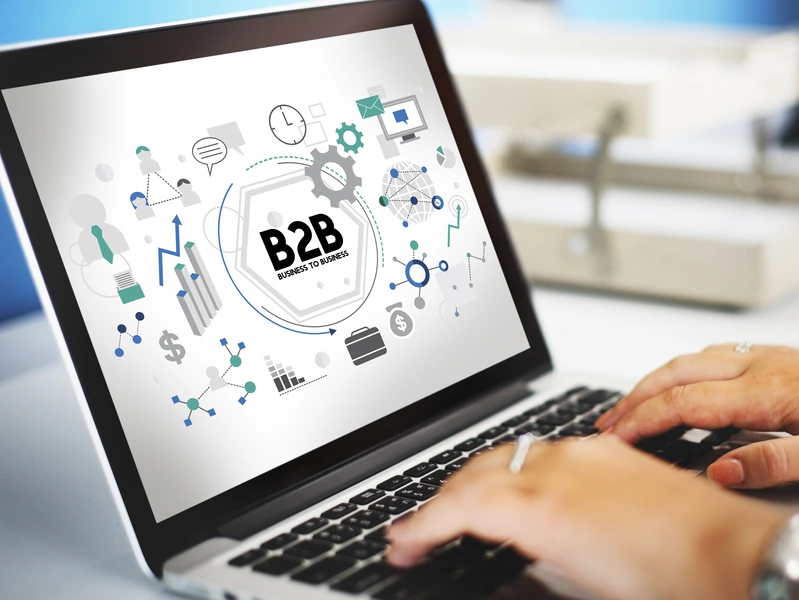The answer isn’t what most B2B SaaS founders expect: it’s not about choosing between GEO and SEO, it’s about understanding how they create dramatically different buyer experiences and lead to different types of qualified prospects. SaaS companies discovering that GEO-driven leads convert 60% faster than traditional SEO leads, not because GEO is “better,” but because it captures prospects at a completely different stage of their buying journey.
Here’s the counterintuitive truth: while SEO brings more total leads, GEO brings leads who are further along in their decision-making process and require less nurturing to convert. The key is understanding which type of lead quality aligns with your sales team’s strengths and your customer acquisition strategy.
How AI Search Changes B2B Buying
B2B buyers are fundamentally changing how they research solutions, and this shift is creating new categories of lead quality that traditional marketing metrics can’t capture.
Traditional SEO Lead Journey:
- Searches “project management software”
- Browses multiple vendor websites
- Downloads several whitepapers
- Compares features across 5-10 options
- Takes 3-6 months to make a decision
AI Search (GEO) Lead Journey:
- Asks ChatGPT “What’s the best project management tool for a 50-person engineering team using agile methodology?”
- Receives personalized recommendations with reasoning
- Directly visits 2-3 recommended solutions
- Books demos within 2-4 weeks
The difference isn’t just speed, it’s intent sophistication. As recent research shows, AI search is “reshaping the B2B buyer’s journey” by providing contextual, conversational guidance that moves prospects from problem awareness to solution evaluation in a single interaction.

Lead Quality Metrics That Actually Matter in 2025
Traditional lead scoring focused on demographic data and basic behavioral signals. The AI search requires new quality indicators that reflect how sophisticated buyers interact with different discovery channels.
SEO Lead Quality Indicators
High-Value SEO Leads Show:
- Long-tail, specific search queries indicating defined requirements
- Multiple page visits showing thorough research behavior
- Content engagement with implementation and ROI-focused materials
- Return visits over extended periods (weeks or months)
SEO Lead Characteristics:
- Higher initial volume but lower immediate conversion intent
- Extensive comparison shopping and competitive research
- Longer sales cycles but potentially higher lifetime value
- More price-sensitive and feature-focused evaluation
GEO Lead Quality Indicators
High-Value GEO Leads Show:
- Conversational queries that include specific context and constraints
- Direct navigation to solution pages rather than educational content
- Immediate demo requests or sales contact within first few sessions
- Questions focused on implementation and integration rather than basic features
GEO Lead Characteristics:
- Lower volume but higher immediate purchase intent
- Less comparison shopping, more focused evaluation
- Shorter sales cycles with faster decision-making
- More value-focused and outcome-oriented discussions
Why GEO Produces Higher Quality Leads
The lead quality difference between GEO and SEO isn’t coincidental, it’s caused by three fundamental factors that change how buyers interact with information.
Factor 1: Query Context Richness
SEO queries are typically sparse: “project management software” or “CRM tools”
GEO queries include rich context: “What’s the best project management software for a remote team of 15 developers using agile methodology with Slack integration?”
This context richness means GEO leads arrive having already provided detailed qualification information. They’ve essentially pre-screened themselves by describing their specific situation, team size, methodology, and integration requirements.
Factor 2: AI-Mediated Recommendation Trust
When ChatGPT or Claude recommends your solution, it carries implicit third-party credibility. The buyer isn’t just finding you, they’re receiving a recommendation from a system they trust for expert advice.
This creates psychological pre-commitment. The buyer has already been “sold” on your solution by the AI before they even visit your website, dramatically reducing the skepticism and evaluation barriers that SEO traffic typically faces.
Factor 3: Conversational Decision-Making Process
AI search mimics human consultation behavior. When someone asks an AI “What should I choose?” they’re mentally prepared to act on the recommendation, similar to asking a trusted advisor.
SEO users, by contrast, are conducting research with the explicit intention of comparing multiple options. They’re in evaluation mode, not decision mode.

The Buyer Journey Psychology: Why AI Search Creates Different Lead Types
Understanding these fundamental differences helps explain the psychological state of buyers when they use each channel.
SEO Buyer Psychology: Exploration and Education
When B2B buyers use traditional search, they’re typically in exploration mode. They know they have a problem but aren’t sure about solutions, vendors, or even the full scope of what they need.
This creates leads who:
- Need extensive education and nurturing
- Require strong competitive differentiation
- Benefit from comprehensive content marketing
- Convert through relationship-building over time
Optimal SEO Lead Nurturing Strategy:
- Educational content that builds expertise and trust
- Progressive profiling to understand specific requirements
- Competitive comparison content that positions your solution favorably
- Long-term relationship building through consistent value delivery
GEO Buyer Psychology: Consultation and Validation
When buyers ask AI systems for recommendations, they’ve already done significant internal research and decision-making. They’re seeking expert validation and specific recommendations, not general education.
The “Expert Consultation” Mindset:
- Buyers approach AI like they would a trusted consultant
- They provide context because they expect personalized advice
- They’re mentally prepared to act on recommendations
- They view AI suggestions as pre-vetted options worth serious consideration
This creates leads who:
- Arrive with pre-qualified requirements and context
- Need validation and proof points rather than education
- Benefit from immediate, relevant demonstrations
- Convert through quick credibility establishment
Why This Matters for Lead Quality: The consultation mindset means GEO leads have already mentally progressed from “What options exist?” to “Which specific option should I choose?” They arrive at your website as warm prospects rather than cold researchers.
Optimal GEO Lead Conversion Strategy:
- Immediate response with relevant, specific information
- Quick demonstration of solution fit for their stated requirements
- Social proof and credibility indicators prominently displayed
- Streamlined evaluation process focused on decision-making
Strategic Framework: Optimizing for Your Ideal Lead Profile
The choice between emphasizing GEO or SEO shouldn’t be based on which produces “better” leads, it should align with your sales team’s strengths, your product’s complexity, and your customer acquisition cost targets.
SEO-First Strategy Works Best For:
- Complex solutions requiring extensive buyer education
- Competitive markets where differentiation requires detailed comparison
- Sales teams skilled in consultative, relationship-building approaches
- Companies with strong content marketing capabilities
- Products with longer implementation timelines that justify extended sales cycles
SEO Success Indicators:
- Sales team comfortable with 3-6 month sales cycles
- Strong marketing content creation and nurturing capabilities
- Competitive advantage in thought leadership and expertise demonstration
- Customer success stories that support extended evaluation periods
GEO-First Strategy Works Best For:
- Solutions with clear, demonstrable value propositions
- Products that solve well-defined, commonly understood problems
- Sales teams optimized for rapid qualification and demonstration
- Companies needing to reduce customer acquisition costs quickly
- Products with quick setup and fast time-to-value
GEO Success Indicators:
- Sales team optimized for fast-moving, high-intent prospects
- Product demonstration capabilities that quickly establish fit
- Strong customer success metrics that support rapid decision-making
- Competitive advantages that are immediately apparent
Measuring Success: Beyond Traditional Lead Quality Metrics
Success in the GEO vs SEO context requires metrics that capture the full customer acquisition picture, not just lead volume or immediate conversion rates.
Revenue Quality Metrics
Customer Lifetime Value by Channel:
- Track CLV differences between SEO and GEO-sourced customers
- Analyze retention rates and expansion revenue by discovery channel
- Measure time-to-value and product adoption patterns
Sales Efficiency Metrics:
- Cost per acquisition including sales team time investment
- Revenue per sales hour by lead source
- Pipeline velocity and predictability by channel
Market Position Metrics:
- Brand recognition and authority establishment over time
- Competitive positioning effectiveness in each channel
- Market share growth attributable to different discovery methods
The Future of B2B SaaS Lead Quality
The convergence of AI search and traditional search is creating new hybrid buyer behaviors that smart B2B SaaS companies are already preparing for.
Emerging Buyer Patterns:
- Initial research through AI systems, validation through traditional search
- AI-assisted competitive analysis followed by direct vendor engagement
- Conversational discovery leading to specific feature and integration research
The companies winning in this evolving landscape understand that lead quality isn’t about choosing the “best” channel, it’s about creating systems that capture and convert different types of high-intent prospects effectively.
Strategic Preparation for 2025 and Beyond:
- Develop sales processes optimized for both lead types
- Create content strategies that work across all discovery methods
- Build measurement systems that account for different conversion patterns
- Train teams to recognize and respond to different buyer psychologies
The future belongs to B2B SaaS companies that can excel at converting both the thoughtful, research-heavy SEO lead and the high-context, ready-to-evaluate GEO lead. The question isn’t which channel produces better leads, it’s whether your organization can optimize for both types of quality.
